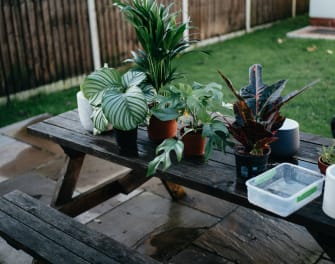Indoor plants beautify your home and create relaxing environments—and choosing plants that please you and do well indoors is important. What else matters: selecting the right pottery, including the optimal size, because right-sized pots help plants to thrive. As a secondary issue, choosing indoor plant pottery in the right proportions adds attractive touches to your home.

Right-Sizing Your Indoor Pottery
You don’t want a pot that’s too small or too large. You want one that’s just right. When a pot is too small, the soil will dry out quickly, which can cause problems for plants that need consistent moistness (although this may be helpful for cacti and succulents that do well in drier soil). Plus, when there isn’t enough room for roots to grow in a pot, many plants won’t flourish.
You also don’t want a pot that’s too big. When you pick too-large indoor planters, they can hold excess water, so soil will take too long to dry. This in turn can trigger mold growth. Plus, if a plant grows best when root bound, it probably won’t do well in pots that are too large.
Range of Sizes: Small to Large Indoor Planters
A pot’s measurement is determined by its diameter. Standard sizes range from two to thirty inches although the ones at the larger end of the scale are mostly used outdoors. Common sizes used indoors are two, three, five, and seven inches.
When picking the size of your indoor pottery, consider what plant you’ll put in it and the anticipated diameter of its root system. Then, pick a pot that’s at least one inch wider. If a plant is likely to grow quickly and significantly, pick pottery that’s a few inches wider than what you expect the root mass to become.
Potting and Repotting
Sometimes, plant growth means you’ll need to transfer your plants to larger indoor pottery. When that happens, you’ll want to properly repot those plants for overall health and continued growth. (Other times, the plant will simply require fresh potting soil.)
Here are tips from our Decker’s Nursery experts.
- Choose the size of the indoor pot you’ll need for the plant’s current condition, using guidance already described in this post.
- Put a ceramic shard over the drainage hole in your new pottery before pouring in the potting mix. This helps to keep any from leaking out.
- Fill the pot with enough mix. You can tell if it’s right if you can position the root mass an inch or two below the rim.
- Remove the plant from the pot it has outgrown and cut off brown roots. Then, use clean, sharp scissors to make half-inch horizontal cuts down the root ball, doing so every few inches.
- Put the plant in its new, larger indoor pottery. Then, gently nudge soil around the roots as you carefully tamp it down to eliminate air pockets.
When repotting from a container that’s ten inches in diameter or less, you’ll often need to boost pot size, diameter-wise, by an inch or two. If you’ve already been using large indoor pots (ones more than ten inches), you’ll likely need to repot in ones that are two or three inches greater, diameter-wise.
Any time you’re shopping for indoor pottery for your plants, keep the issue of drainage in mind. Here are tips on providing proper drainage in your indoor plant pottery and more.
Expanding Root Mass
In a fascinating study published in the Society for Experimental Biology, scientists documented how a potted plant’s roots will evolve as the plant develops. Using 3-D MRI root scans, they could observe how potted plants extended their roots towards the sides of the pottery—and fairly quickly, too. The role of roots, then, may include sensing the size of their environment although the details of how the roots relay the message about the pot's size remain the plant’s secret.” Only Mother Nature knows, at least for the time being!
Reusing Indoor Plant Pottery
After you repot a plant, you can reuse the original pot for another plant that’s well suited for it, but you’ll want to thoroughly clean that pot, inside and out. That way, you can help to prevent the new plant from becoming diseased.
From Small to Large Indoor Planters: Aesthetics Also Matter
Picking the right size pot for your indoor plants is crucial for plant health, and you’ll also want your pottery to look attractive in your home. So, choose the right indoor plant pottery material with commonly used ones including:
- Terra cotta
- Ceramic
- Plastic
- Fiberglass
- Wood and metal
- Concrete
You’ll also want to choose pots in the right proportions. If you appreciate delicate flowers, for example, then a rugged pot with thick rims may swallow up the plant. If your plant will grow to be tall, then a shorter pot (even if there’s enough room for the root mass and growth) may cause the plant-pot combo to look out of proportion. If you’re going to put indoor pottery on your coffee table, then think about what would look attractive—which would be different from what would be eye-catching on the floor of your home.
To prioritize selections, first ensure that the indoor plant pottery you choose will help to maximize its health. Then, from those possibilities, pick ones in the materials, styles, and proportions that will create the most beautiful effect for your home.
Indoor Pottery at Decker’s Nursery
Questions? Here at Decker’s Nursery, we’re happy to help. We love to help people connect with the natural world, including inside of their homes. To find the right indoor pottery, visit our full-service retail garden center during business hours. Or you can contact us online, call (631) 261-1148, or email us at hello@deckers-nursery.com.
